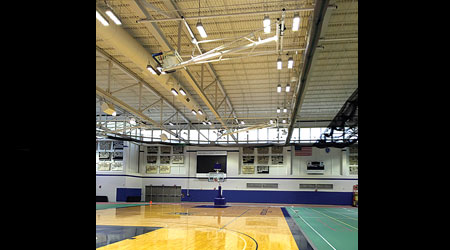How To Reduce Water Heating Energy On Campus
Part 2 of a 3-part article on how educational facilities can implement energy-saving strategies.
Another significant energy use on campuses is water heating. A no-cost solution that every facility manager should use is turning down the water heaters to a lower temperature in buildings that do not have laboratories or kitchens (assuming the system has a storage tank and local codes will allow it). In some instances, it may be more efficient to provide labs and kitchens with their own tankless water heaters.
In conjunction with making the hot water generation more efficient, end uses should also be addressed. Low-flow faucets and showerheads, as well as metered showers and faucets, can help conserve water and the energy used to heat that water. In recreational buildings, field houses, or even in some dormitories, it may be feasible to use instant water heaters in lieu of tank type water heaters.
A benefit that is often overlooked with the increasingly popular variable refrigerant flow (VRF) HVAC system is the implementation of a heat exchange between the refrigerant and domestic water. The hot refrigerant can be used to preheat this water prior to returning to the heat pump in an air-cooled system. This water can then be used directly for showers or other uses that are allowed by code to use greywater. If a double-walled heat exchange storage tank is installed, then this pre-heated water can be used for potable uses as well.
Once a college or university decides to pursue an energy conservation plan and improve energy awareness, it tends to start with the easiest energy conservation measures. These are often referred to as the low-hanging fruit. The drawback with this approach is that once all of these low-cost or no-cost energy conservation measures have been implemented, the ones that remain have longer paybacks that make them financially unattractive. This in turn makes replacing the boiler plant or replacing failing windows much more difficult to implement, even though they may be a dire need for the college.
One way to avoid this is to combine some of the higher cost measures with the low-hanging fruit. This strategy can create a comprehensive energy savings plan that is more financially attractive. Combining lighting replacements with replacing or upgrading a boiler or chiller will often result in an overall project that is fairly easy to justify. This approach, in effect, allows the shorter payback energy conservation measures to finance the longer payback measures, which creates a shorter payback for the energy plan as a whole.
It is a challenge to achieve significant energy savings while keeping in mind the ultimate goals of the college, and more importantly, the budget. This is when a consulting engineer should be considered to help create and implement the energy saving goals. The engineer can help identify the most efficient solution possible that will allow for long-term energy savings, the highest level of ROI and solutions that are easily maintained by existing college staff.
Due to differences in location, fuel sources, and even the types of classes offered (and therefore facilities needed), there is no “one size fits all” energy efficiency approach for every college or university. There are however, multiple opportunities on every college campus to save energy and to package energy conservation measures together in such a way that energy efficiency is attractive to everyone from campus personnel to its students. When the entire college community is working toward saving energy, very significant energy savings can be realized.
Timothy Chatterton, PE, is an architectural engineer and energy auditor at RMF Engineering, where he has been involved in many different types of energy improvement projects. Chatterton has 18 years experience in the engineering industry. He can be reached at tim.chatterton@rmf.com.
Email comments to edward.sullivan@tradepress.com.
Related Topics:














